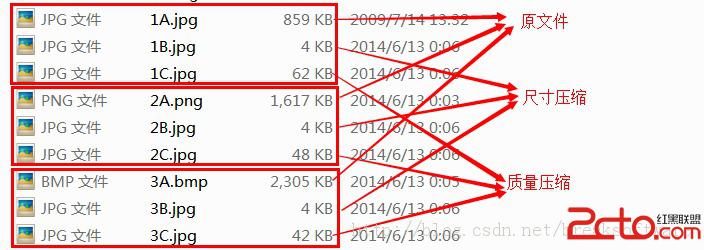今天同事向我詢問圖片壓縮的算法,我想起大概兩三年前做過的一個項目。其中包含了尺寸和質量兩種壓縮算法,並且支持JPEG、bmp、PNG等格式。今天把這段邏輯貼出來,供大家參考。(轉載請指明來源於breaksoftware的CSDN博客)
尺寸壓縮bool CompressImagePixel(
const WCHAR* pszOriFilePath,
const WCHAR* pszDestFilePah,
UINT ulNewHeigth,
UINT ulNewWidth )
{
// Initialize GDI+.
GdiplusStartupInput gdiplusStartupInput;
ULONG_PTR gdiplusToken;
Status stat = GenericError;
stat = GdiplusStartup( &gdiplusToken, &gdiplusStartupInput, NULL );
if ( Ok != stat ) {
return false;
}
// 重置狀態
stat = GenericError;
// Get an image from the disk.
Image* pImage = new Image(pszOriFilePath);
do {
if ( NULL == pImage ) {
break;
}
// 獲取長寬
UINT unOriHeight = pImage->GetHeight();
UINT unOriWidth = pImage->GetWidth();
do {
CLSID encoderClsid;
if ( unOriWidth < 1 || unOriHeight < 1 ) {
break;
}
// Get the CLSID of the JPEG encoder.
if ( !GetEncoderClsid(L"image/jpeg", &encoderClsid) ) {
break;
}
REAL fSrcX = 0.0f;
REAL fSrcY = 0.0f;
REAL fSrcWidth = (REAL) unOriWidth;
REAL fSrcHeight = (REAL) unOriHeight ;
RectF RectDest( 0.0f, 0.0f, (REAL)ulNewWidth, (REAL)ulNewHeigth);
Bitmap* pTempBitmap = new Bitmap( ulNewWidth, ulNewHeigth );
Graphics* graphics = NULL;
do {
if ( !pTempBitmap ) {
break;
}
graphics = Graphics::FromImage( pTempBitmap );
if ( !graphics ) {
break;
}
stat = graphics->SetInterpolationMode(Gdiplus::InterpolationModeHighQuality);
if ( Ok != stat ) {
break;
}
stat = graphics->SetSmoothingMode(Gdiplus::SmoothingModeHighQuality);
if ( Ok != stat ) {
break;
}
stat = graphics->DrawImage( pImage, RectDest, fSrcX, fSrcY, fSrcWidth, fSrcHeight,
UnitPixel, NULL, NULL, NULL);
if ( Ok != stat ) {
break;
}
stat = pTempBitmap->Save( pszDestFilePah, &encoderClsid, NULL );
if ( Ok != stat ) {
break;
}
} while(0);
if ( NULL != graphics ) {
delete graphics;
graphics = NULL;
}
if ( NULL != pTempBitmap ) {
delete pTempBitmap;
pTempBitmap = NULL;
}
} while(0);
} while (0);
if ( pImage ) {
delete pImage;
pImage = NULL;
}
GdiplusShutdown(gdiplusToken);
return ( ( Ok == stat ) ? true : false );
}
質量壓縮
bool CompressImageQuality(
const WCHAR* pszOriFilePath,
const WCHAR* pszDestFilePah,
ULONG quality )
{
// copy from http://msdn.microsoft.com/en-us/library/ms533844(v=VS.85).aspx
// Initialize GDI+.
GdiplusStartupInput gdiplusStartupInput;
ULONG_PTR gdiplusToken;
Status stat = GenericError;
stat = GdiplusStartup( &gdiplusToken, &gdiplusStartupInput, NULL );
if ( Ok != stat ) {
return false;
}
// 重置狀態
stat = GenericError;
// Get an image from the disk.
Image* pImage = new Image(pszOriFilePath);
do {
if ( NULL == pImage ) {
break;
}
// 獲取長寬
UINT ulHeight = pImage->GetHeight();
UINT ulWidth = pImage->GetWidth();
if ( ulWidth < 1 || ulHeight < 1 ) {
break;
}
// Get the CLSID of the JPEG encoder.
CLSID encoderClsid;
if ( !GetEncoderClsid(L"image/jpeg", &encoderClsid) ) {
break;
}
// The one EncoderParameter object has an array of values.
// In this case, there is only one value (of type ULONG)
// in the array. We will let this value vary from 0 to 100.
EncoderParameters encoderParameters;
encoderParameters.Count = 1;
encoderParameters.Parameter[0].Guid = EncoderQuality;
encoderParameters.Parameter[0].Type = EncoderParameterValueTypeLong;
encoderParameters.Parameter[0].NumberOfValues = 1;
encoderParameters.Parameter[0].Value = &quality;
stat = pImage->Save(pszDestFilePah, &encoderClsid, &encoderParameters);
} while(0);
if ( pImage ) {
delete pImage;
pImage = NULL;
}
GdiplusShutdown(gdiplusToken);
return ( ( stat == Ok ) ? true : false );
} 這兩個算法,都關聯了一個函數GetEncoderClsid,其實現是:
#include在我的測試代碼中,文件名中包含A的為源文件,文件名中包含B的是尺寸壓縮算法得到的文件,文件名中包含C的是質量壓縮(尺寸不變)算法得到的文件。測試代碼是#include #pragma comment( lib, "GdiPlus.lib" ) using namespace Gdiplus; bool GetEncoderClsid(const WCHAR* pszFormat, CLSID* pClsid) { UINT unNum = 0; // number of image encoders UINT unSize = 0; // size of the image encoder array in bytes ImageCodecInfo* pImageCodecInfo = NULL; // How many encoders are there? // How big (in bytes) is the array of all ImageCodecInfo objects? GetImageEncodersSize( &unNum, &unSize ); if ( 0 == unSize ) { return false; // Failure } // Create a buffer large enough to hold the array of ImageCodecInfo // objects that will be returned by GetImageEncoders. pImageCodecInfo = (ImageCodecInfo*)( malloc(unSize) ); if ( !pImageCodecInfo ) { return false; // Failure } // GetImageEncoders creates an array of ImageCodecInfo objects // and copies that array into a previously allocated buffer. // The third argument, imageCodecInfos, is a pointer to that buffer. GetImageEncoders( unNum, unSize, pImageCodecInfo ); for ( UINT j = 0; j < unNum; ++j ) { if ( wcscmp( pImageCodecInfo[j].MimeType, pszFormat ) == 0 ) { *pClsid = pImageCodecInfo[j].Clsid; free(pImageCodecInfo); pImageCodecInfo = NULL; return true; // Success } } free( pImageCodecInfo ); pImageCodecInfo = NULL; return false; // Failure }
int _tmain(int argc, _TCHAR* argv[])
{
CompressImagePixel( L"1A.jpg", L"1B.jpg", 100, 100 );
CompressImageQuality( L"1A.jpg", L"1C.jpg", 30 );
CompressImagePixel( L"2A.png", L"2B.jpg", 100, 100 );
CompressImageQuality( L"2A.png", L"2C.jpg", 30 );
CompressImagePixel( L"3A.bmp", L"3B.jpg", 100, 100 );
CompressImageQuality( L"3A.bmp", L"3C.jpg", 30 );
return 0;
} 其壓縮結果是
